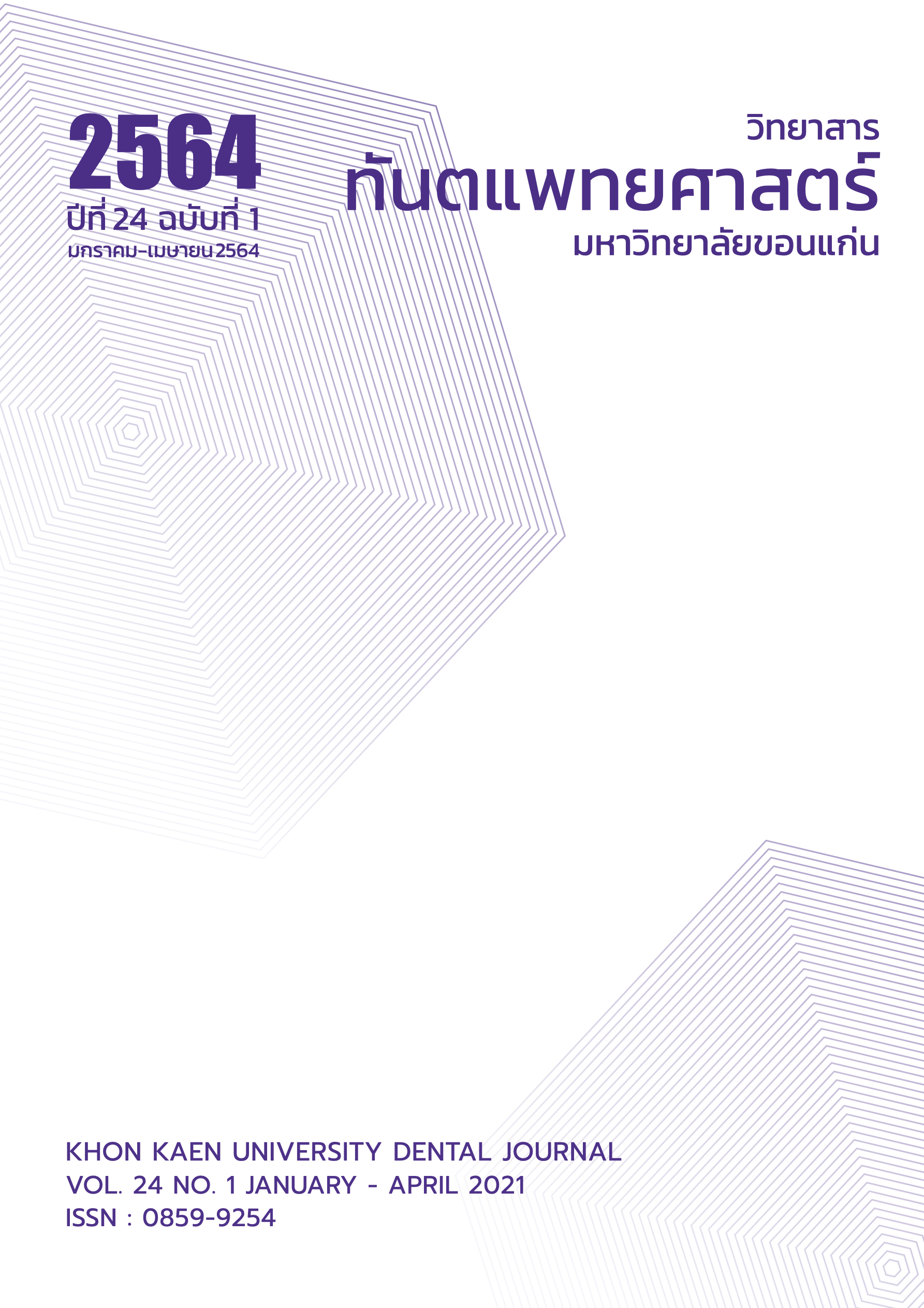Effect of Nano-Titanium Dioxide on the Color Stability and Mechanical Properties of Factor II A-103 Compare with Multisil-Epithetics Maxillofacial Silicone Elastomer
Main Article Content
Abstract
The objectives of this study were to evaluate the effects of nano-titanium dioxide on the color stability of pigmented silicone Factor II A-103 maxillofacial prosthetic elastomers compare with Multisil- Epithetics before and after artificial aging and to evaluate physical properties. Fifty disc-shaped maxillofacial silicone elastomer specimens in each group were fabricated for color stability evaluation. The first group was fabricated from Factor II A-103 with 2% wt nano-titanium dioxide, the second group was fabricated from Factor II A-103 without 2% wt nano-titanium dioxide and the last group was fabricated from Multisil-Epithetics. The first and the second group were colored with intrinsic silicone pigment for the same color like Multisil-Epithetics. Total of 150 specimens were aged in an artificial aging chamber (Q-Sun xenon test chamber LX 5050, USA) for 600 hrs. Color changes (ΔE*) were calculated based on the recorded CIElab values using spectrophotometer (HunterLab, ColorQuest ® XE, USA) at base line (0 hour) and then every 100 hours up to 600 hours of aging. For the physical properties test 16 dumbbell-shaped and 16 trouser-shaped of each group were fabricated and tested for tensile strength, percentage elongation and tear strength in a universal testing machine. Kruskal-Wallis was performed for analyze the differences among group at 95% confidence level and Friedman’s two way ANOVA was used to compare mean ΔE* value of each group in each time period (100-600 hrs.). For color stability test, Multisil-Epithetics exhibited smallest color changes (ΔE*=3.67) followed by Factor II A-103 with 2% wt nano-titanium dioxide (ΔE*=10.8) and Factor II A-103 without 2% wt nano-titanium dioxide (ΔE*=11.03) respectively. Multisil-Epithetics had statistically significant differences in comparison to the other groups (p<0.001). Delta-E values of all groups after 600 hours aging was higher than acceptable threshold (ΔE*=3.3). For mechanical properties test, Factor II A-103 with 2% wt nano-titanium dioxide demonstrated significantly higher tensile strength, percentage elongation and tear strength than Multisil-Epithetics (P<0.001). There was no significant difference of tensile strength, percentage elongation and tear strength between Factor II A-103 with and without 2% wt nano-titanium dioxide. In conclusions, incorporation of nano-titanium dioxide improved the color stability of Factor II A-103 silicone elastomer in 300 hrs. from artificial aging, but did not improve the color stability in the long term and did not improve the physical properties of the material.
Article Details
บทความ ข้อมูล เนื้อหา รูปภาพ ฯลฯ ที่ได้รับการลงตีพิมพ์ในวิทยาสารทันตแพทยศาสตร์ มหาวิทยาลัยขอนแก่นถือเป็นลิขสิทธิ์เฉพาะของคณะทันตแพทยศาสตร์ มหาวิทยาลัยขอนแก่น หากบุคคลหรือหน่วยงานใดต้องการนำทั้งหมดหรือส่วนหนึ่งส่วนใดไปเผยแพร่ต่อหรือเพื่อกระทำการใด ๆ จะต้องได้รับอนุญาตเป็นลายลักษณ์อักษร จากคณะทันตแพทยศาสตร์ มหาวิทยาลัยขอนแก่นก่อนเท่านั้น
References
Kiat-amnuay S, Beerbower M, Powers JM, Paravina RD. Influence of pigments and opacifiers on color stability of silicone maxillofacial elastomer.J Dent 2009;37(1): 45-50.
Hatamleh MM, Watts DC. Mechanical properties and bonding of maxillofacial silicone elastomers. Dent Mater 2010;26(2):185-91.
The Academy of Prosthodontics Foudation . The Glossary of Prosthodontic Terms. J prosthet Dent (Internet). 2017[cited 2020 March 1]; 117(5):56. Available from:https://www.Academy of prosthodontics. org/_Library/ ap_articles_download/ GPT9.pdf
Mahajan H, Gupta K. Maxillofacial Prosthetic Materials: A Literature Review. J Orofac Res 2012;2(2):87-90.
Barhate A, Gangadhar S, Bhandari A, Joshi A. Materials usedin maxillofacial prosthesis : A review. Pravara Med Rev 2015;7(1):5-8.
Mohammad SA, Wee AG, Rumsey DJ, Schricker SR. Maxillofacial Materials Reinforced with Various Concentrations of Polyhedral Silsesquioxanes. J Dent Biomech 2010;1-6.
Mitra A, Choudhary S, Garg H, Jagadeesh HG. Maxillofacial prosthetic materials- an inclination towards silicones. J Clin and Diagn Res 2014;8(12):08-13.
Lai JH, Wang LL, Ko CC, DeLong RL, Hodges JS. New organosilicon maxillofacial prosthetic materials. Dent Mater 2002;18(3):281-6.
Beatty MW, Mahanna GK, Dick K, Jia W. Color changes in dry-pigmented maxillofacial elastomer resulting from ultraviolet light exposure. J Prosthet Dent 1995;74(5): 493-8.
Lemon JC, Chambers MS, Jacobsen ML, Powers JM. Color stability of facial prostheses. J Prosthet Dent 1995; 74(6):613-8.
Polyzois GL. Color stability of facial silicone prosthetic polymers after outdoor weathering. J Prosthet Dent 1999;82(4):447-50.
Han Y, Zhao Y, Xie C, Powers JM, Kiat-amnuay S.Color stability of pigmented maxillofacial silicone elastomer: Effects of nano-oxides as opacifiers. J Dent 2010;38(2): 100-5.
Han Y, Kiat-amnuay S, Powers JM, Zhao Y. Effect of nano-oxide concentration on the mechanical properties of a maxillofacial silicone elastomer. J Prosthet Dent 2008; 100(6):465-73.
Akash RN, Guttal SS. Effect of Incorporation of nano-oxides on color stability of maxillofacial silicone elastomer subjected to outdoor weathering. J Prosthodont 2015; 24(7): 569-75.
Shakir DA, Abdul - Ameer FM. Effect of nano titanium oxide addition on color stability on two types of maxillofacial silicone materials. Int J Sci Res 2017; 6(12): 1796-1801.
Eltayyar NH, Alshimy AM, Abushelib MN. Evaluation of intrinsic color stability of facial silicone elastomer reinforced with different nanoparticles. Alex Dent J 2016; 41(1):50-4.
Li R, Yabe S, Yamashita M, Momose S, Yoshida S, Yin S, et al. UV-shielding properties of zinc oxide-doped ceria fine powders derived via soft solution chemical routes. Mater Chem Phys 2002;75(1):39-44.
Sujaridworakun P. Titanium dioxide photocatalyst and daily life. J MTEC 2005;(40):76-9.
Allen NS, Edge M, Ortega A, Sandoval G, Liauw CM, Verran J, et al. Degradation and stabilisation of polymers and coatings: nano versus pigmentary titania particles. Polym Degrad Stabil 2004;85(3):927-46.
Farah A, Sherriff M, Coward T. Color stability of nonpigmented and pigmented maxillofacial silicone elastomer exposed to 3 different environments. J Prosthet Dent 2018;120(3):476-82.
Beumer J, Reisberg DJ, Marunick MT, Powers JM, Kiat-amnuay S, Oort RV. Rehabilitation of Facial Defects. In : Beumer J, Marunick MT, Esposito S, editors. Maxillofacial Rehabilitation: Prosthodontic and Surgical Considerations. 3rd ed. Chicago : Quintessence Publishing; 2011. 255-313.
Wang L, Liu Q, Jing D, Zhou S, Shao L. Biomechanical properties of nano-TiO2 addition to a medical silicone elastomer: The effect of artificial ageing. J Dent 2014; 42(4):475-83.
Radey NS, AI Shimy AM, Ahmed DM. Effect of extraoral aging conditions on mechanical properties of facial silicone elastomer reinforced titanium-oxide nanoparticles (In vitro study). Alex Dent J 2019;20(10):1-26.
Zhu A-J, Sternstein SS. Nonlinear viscoelasticity of nanofilled polymers: interfaces, chain statistics and properties recovery kinetics. Compos Sci Technol 2003; 63(8):1113-26.
Bellamy K, Limbert G, Waters MG, Middleton J.An elastomeric material for facial prostheses:synthesis, experimental and numerical testing aspects.Biomaterials 2003;24(27):5061-6.


